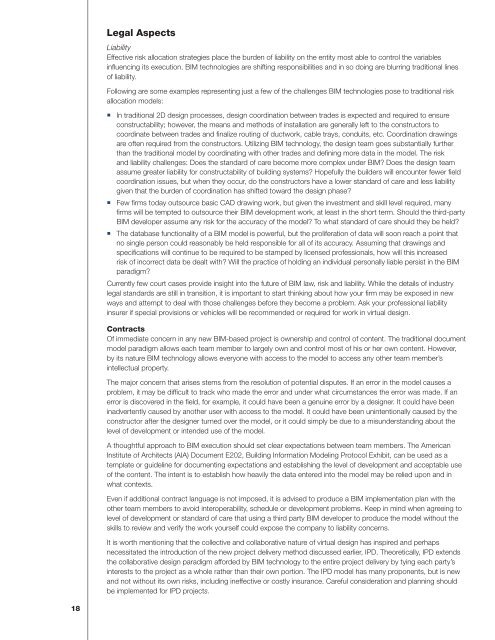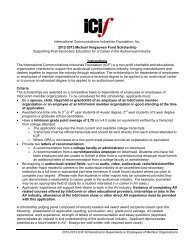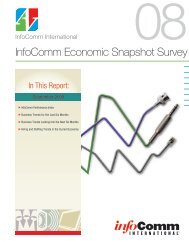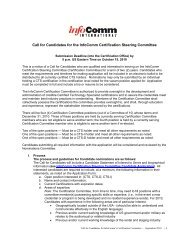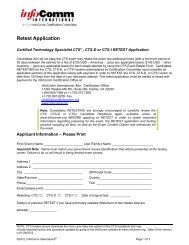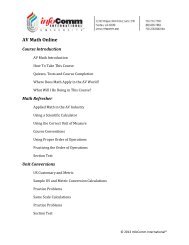Building Information Modeling (BIM) - InfoComm International
Building Information Modeling (BIM) - InfoComm International
Building Information Modeling (BIM) - InfoComm International
You also want an ePaper? Increase the reach of your titles
YUMPU automatically turns print PDFs into web optimized ePapers that Google loves.
18<br />
Legal Aspects<br />
Liability<br />
Effective risk allocation strategies place the burden of liability on the entity most able to control the variables<br />
influencing its execution. <strong>BIM</strong> technologies are shifting responsibilities and in so doing are blurring traditional lines<br />
of liability.<br />
Following are some examples representing just a few of the challenges <strong>BIM</strong> technologies pose to traditional risk<br />
allocation models:<br />
In traditional 2D design processes, design coordination between trades is expected and required to ensure<br />
constructability; however, the means and methods of installation are generally left to the constructors to<br />
coordinate between trades and finalize routing of ductwork, cable trays, conduits, etc. Coordination drawings<br />
are often required from the constructors. Utilizing <strong>BIM</strong> technology, the design team goes substantially further<br />
than the traditional model by coordinating with other trades and defining more data in the model. The risk<br />
and liability challenges: Does the standard of care become more complex under <strong>BIM</strong>? Does the design team<br />
assume greater liability for constructability of building systems? Hopefully the builders will encounter fewer field<br />
coordination issues, but when they occur, do the constructors have a lower standard of care and less liability<br />
given that the burden of coordination has shifted toward the design phase?<br />
Few firms today outsource basic CAD drawing work, but given the investment and skill level required, many<br />
firms will be tempted to outsource their <strong>BIM</strong> development work, at least in the short term. Should the third-party<br />
<strong>BIM</strong> developer assume any risk for the accuracy of the model? To what standard of care should they be held?<br />
The database functionality of a <strong>BIM</strong> model is powerful, but the proliferation of data will soon reach a point that<br />
no single person could reasonably be held responsible for all of its accuracy. Assuming that drawings and<br />
specifications will continue to be required to be stamped by licensed professionals, how will this increased<br />
risk of incorrect data be dealt with? Will the practice of holding an individual personally liable persist in the <strong>BIM</strong><br />
paradigm?<br />
Currently few court cases provide insight into the future of <strong>BIM</strong> law, risk and liability. While the details of industry<br />
legal standards are still in transition, it is important to start thinking about how your firm may be exposed in new<br />
ways and attempt to deal with those challenges before they become a problem. Ask your professional liability<br />
insurer if special provisions or vehicles will be recommended or required for work in virtual design.<br />
Contracts<br />
Of immediate concern in any new <strong>BIM</strong>-based project is ownership and control of content. The traditional document<br />
model paradigm allows each team member to largely own and control most of his or her own content. However,<br />
by its nature <strong>BIM</strong> technology allows everyone with access to the model to access any other team member’s<br />
intellectual property.<br />
The major concern that arises stems from the resolution of potential disputes. If an error in the model causes a<br />
problem, it may be difficult to track who made the error and under what circumstances the error was made. If an<br />
error is discovered in the field, for example, it could have been a genuine error by a designer. It could have been<br />
inadvertently caused by another user with access to the model. It could have been unintentionally caused by the<br />
constructor after the designer turned over the model, or it could simply be due to a misunderstanding about the<br />
level of development or intended use of the model.<br />
A thoughtful approach to <strong>BIM</strong> execution should set clear expectations between team members. The American<br />
Institute of Architects (AIA) Document E202, <strong>Building</strong> <strong>Information</strong> <strong>Modeling</strong> Protocol Exhibit, can be used as a<br />
template or guideline for documenting expectations and establishing the level of development and acceptable use<br />
of the content. The intent is to establish how heavily the data entered into the model may be relied upon and in<br />
what contexts.<br />
Even if additional contract language is not imposed, it is advised to produce a <strong>BIM</strong> implementation plan with the<br />
other team members to avoid interoperability, schedule or development problems. Keep in mind when agreeing to<br />
level of development or standard of care that using a third party <strong>BIM</strong> developer to produce the model without the<br />
skills to review and verify the work yourself could expose the company to liability concerns.<br />
It is worth mentioning that the collective and collaborative nature of virtual design has inspired and perhaps<br />
necessitated the introduction of the new project delivery method discussed earlier, IPD. Theoretically, IPD extends<br />
the collaborative design paradigm afforded by <strong>BIM</strong> technology to the entire project delivery by tying each party’s<br />
interests to the project as a whole rather than their own portion. The IPD model has many proponents, but is new<br />
and not without its own risks, including ineffective or costly insurance. Careful consideration and planning should<br />
be implemented for IPD projects.


